|
Beirut is the capital and largest city of Lebanon with a population of over 2.1 million as of 2007. Located on a peninsula at the midpoint of Lebanon's coastline with the Mediterranean sea, it serves as the country's largest and main seaport and also forms the Beirut Metropolitan Area, which consists of the city and its suburbs. The first mention of this metropolis is found in the ancient Egyptian Tell el Amarna letters, dating to the 15th century BC, and the city has been continuously inhabited since.
Beirut holds Lebanon's seat of government and plays a central role in the Lebanese economy with its Downtown, Hamra, Verdun, and Ashrafieh based corporate firms and banks. The city is the focal point of the region's cultural life, renowned for its press, theaters, cultural activities, and nightlife. After the destructive Lebanese civil war, Beirut underwent major reconstruction, and the redesigned historic city center, marina, pubs and nightlife districts have once again rendered it a tourist attraction. Beirut was named the top place to visit in 2009 by the New York Times.It was also listed as one of the ten liveliest cities in the world by Lonely Planet in 2009.
Museums
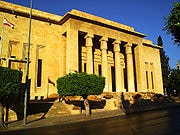
The National Museum of Beirut
The National Museum of Beirut is the principal museum of archaeology in Lebanon. About 1300 artifacts are exhibited, ranging in date from prehistoric times to the medieval Mamluk period.
The American University of Beirut archaeological museum is the third oldest museum in the Middle East, it exhibits a wide range of artifacts from Lebanon and neighboring countries.
Sursock Museum was built by the Sursock family at the end of the 19th century as a private villa. It was then donated to the Lebanese government and now houses Beirut's most influential and popular art museum.
The permanent collection shows a collection of Japanese engravings and numerous works of Islamic art, and temporary exhibitions are shown throughout the year.
Robert Mouawad Private Museum exhibits Henri Pharaon's private archaeology and antiques collection, located near Beirut's the Grand Serail.Planet Discovery is a children’s science museum. It holds interactive experiments, exhibitions, performances and workshops, and awareness competitions.
Arts and fashion
There are hundreds of art galleries in Beirut and its suburbs. Lebanese people are very involved in art and art production. More than 5000 fine art artists and equal artists working in music, design, architecture, theatre, film, photography and other forms of art are producing in Lebanon. Every year hundreds of fine art students graduate from universities and institutions. Artist Workshops are flourishing all around Lebanon.
Recently, The inauguration of the Beirut Art Center in the Jisr El Wati district of Beirut added to the number of exhibition spaces available in Beirut, with an addition of a screening and performance room, mediatheque, bookstore, cafe and terrace.
On another scale, fashion and couture are thriving Fashion houses are opening up and a number of international fashion designers have displayed their work in various fashion shows.
Many fashion designers have opened shops in Beirut such as Versace and Gucci, but many designers live in and around Beirut, for instance Elie Saab a major designer for women's clothing, lives in Beirut. Elie Saab has made dresses for the likes of Beyonce, Gwyneth Paltrow, Halle Berry and Micha Barton. Elie Saab always donates a Christmas tree to downtown Beirut every year.
Another fashion designer from Beirut is Zuhair Murad who has designed clothing for the likes of Ana Ortiz and Christina Applegate. He has worked for Mango clothing line, which has an outlet in Beirut, and has his own retail in Beirut.
Tourism
The once destroyed town center is thriving once again and is much active. Its former reputation as a crossroads between three continents and gateway to the East has been restored and modernized. Beirut is the oft-invoked “Paris of the East”, and there is plenty of sightseeing, shopping, cuisine, and nightlife to keep a tourist within the city limits for the duration a visit to Lebanon. The city has sleek, modern buildings alongside arabesque Ottoman buildings, giving Beirut a unique and distinctive style often not seen in other Middle Eastern cities.
In Travel and Leisure magazine's World Best Awards 2006, Beirut was ranked 9th best city in the world. However, the list was voted upon before the war broke out in Lebanon that same year. Tourist numbers have increased exponentially these last few months. Recently, Lonely Planet named Beirut as ranking in its 2009 top ten liveliest cities on the planet. The New York Times ranked Beirut as the number one place to go in 2009 on its "44 places to go" list of 2009. Many of the tourists are returning Lebanese expatriates, but many are also from Western countries. Approximately two million visitors are expected to visit in 2009; the previous record was 1.4 million in 1974. Tourism was recently helped by the international attention garnered by mass hike to the peak of Mount Hermon on World Tourism Day, 2009.
Byblos
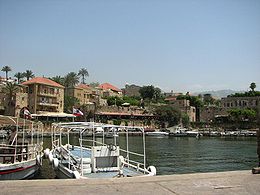 |
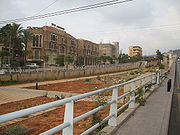 |
Byblos Port |
Byblos, Lebanon |
Byblos is the Greek name of the Phoenician city Gebal (earlier Gubla). It is a Mediterranean city in the Mount Lebanon Governorate of present-day Lebanon under the current Arabic name of Jbeil and was also referred to as Gibelet during the Crusades. It is believed to have been founded around 5000 BC, and according to fragments attributed to the semi-legendary pre-Trojan war Phoenician historian Sanchuniathon, it was built by Cronus as the first city in Phoenicia. Today it is believed by many to be the oldest continuously-inhabited city in the world.
It is mentioned in the Bible in 1 Kings 5:18, referring to the nationality of the builders of Solomon's Temple, and also in Ezekiel 27:9, referring to the riches of Tyre.
Tourism
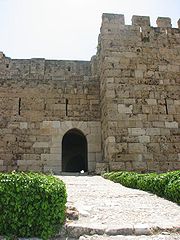 |
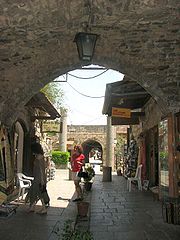 |
Crusader Fort |
Byblos Historic Quarter |
Ancient Phoenician Temples
In the archaeological site of Byblos there are the remains of the Great Temple (also known as L-Shaped temple) built in 2700 BC, Temple of Baalat Gebal built in 2700 BC and Temple of the Obelisks built around 1600 BC.
Byblos Castle
Main article: Byblos Castle
Byblos Castle was built by the crusaders in the 12th century. It is located in the archaeological site near the port.
Medieval City Wall
The old medieval part of Byblos is surrounded by walls running about 270m from east to west and 200m from north to south
Byblos Wax Museum
Main article: Byblos Wax Museum
This museum displays wax statues of characters from Phoenician times to current days
St John the Baptist Church
Work on the church started during the crusades in 1150. It was damaged during an earthquake in the 12th century and also during several conflicts.
Byblos Fossil Museum
Main article: Byblos Fossil Museum
Byblos Fossil Museum has a collection of fossilized fish, sharks, eel, flying fish, and other marine life, some millions of years old.
Historic Quarter and Souks
In the southeast section of the historic city, near the entrance of the archaeological site, is an old market where tourists can shop for souvenirs and antiques, or simply stroll along the old cobblestone streets and enjoy the architecture.
Byblos International Festival
Main article: Byblos International Festival
This summer music festival is an annual event that takes place in the historic quarter.
Today
Today, Byblos (Jbeil) is a modern city. It remains one of Lebanon's biggest tourist attractions, mainly because of its rich history and scenic mountains overlooking the Mediterranean.
As with any metropolitan city, it is advisable to always be cautious of your surroundings. It is also recommended that you leave your valuables in your hotel room, should you leave the hotel on your own.
We also suggest that you use the hotel's transport service should you wish to go shopping, site seeing, etc.
If you have additional questions or needs that have not been answered by the information included on this website, you may send an email with the subject line “Arabian Adventure Roadshow” to Mumen Suliman at msuliman@cisco.com . |
